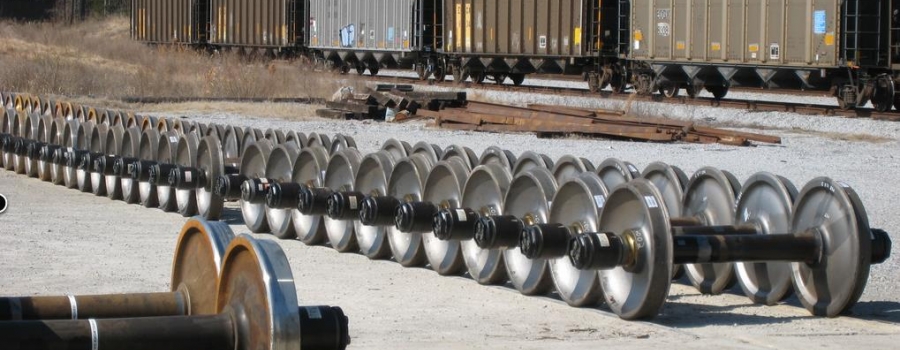
Since its launch three years ago, Railinc's component tracking program has increased the visibility of rail equipment components such as wheelsets, side frames, bolsters and couplers on railcars across North America.
Today, when a newly manufactured wheelset goes into inventory, the wheel shop places a bar code (pictured below) on the axle and registers the wheelset with Railinc’s Umler® component registry. The process enables the car owner to monitor the wheelset and evaluate its performance. If a problem arises, the car owner can target the individual wheelset for research, analysis and even replacement.
“As safety is a top priority, there is a need to know where components such as wheelsets, side frames, bolsters and couplers are located when in service, along with important manufacturing characteristics such as the design code, who manufactured them and where they were manufactured,” said Jerry Vaughn, director of asset services and Umler product manager.
This detailed view of rail equipment health and performance data provides personnel across the rail network with information that may improve rail safety, reduce maintenance costs, and support more efficient and effective rail operations.
And the view is only going to get better. The latest phase of the program is underway and will add key brake valve components to the registry.
How Component Tracking Happens
Railinc works with the freight rail industry through industry committees sponsored by the Association of American Railroads (AAR). The AAR’s Equipment Health Monitoring Committee and other committees help to define data requirements for component registration and develop schedules for mandatory registration and association throughout the industry. The typical timeline for phasing in new components allows for six months of development and a year to implement rule changes.
The component tracking program involves millions of components and big data, so it requires sophisticated and reliable technology.
That’s where Railinc comes in.
The Umler component registry is a dynamic database designed to process updates quickly and efficiently. To accommodate new component specifications, Railinc adds new value in a metadata description and creates the business rules required to ensure high levels of data quality.
“Separating the business rules gives us visibility to decisions that normally occur in the technical code and creates efficiencies that lower our total costs,” Vaughn said.
Wheelsets Lead the Way
The freight rail industry continues to move forward with the adoption of component tagging. According to Vaughn, 55 percent of all wheelsets in the North American railcar fleet now has an associated component ID (CID). Nearly 5 million wheelsets are registered in the Umler component registry, and about 3.3 million wheelsets are associated with individual railcars. Even more wheelsets will get CIDs soon because normal wear requires the replacement or refurbishing of wheelsets about every five years.
The success of the wheelsets phase enabled the addition of side frames, bolsters and couplers to the component tracking program in 2013. And the industry added another component to the program last year.
“The big news in component tracking today is our initiation and support of the service and emergency portions of brakes valve into the program," Vaughn said. “This started as one of Railinc’s 2014 industry projects, which involved Class I railroads, railcar owners, brake valve reconditioners and major brake valve manufacturers.”
Brake valve registration and association are voluntary now. That changes in July, when industry rules will require registration. Mandatory association of brake valves on newly built cars and existing cars begins in January 2016.
Building a component tracking program is like creating a high-tech treasure map. There are more than 1 million places to look for specific components in service across North America. Using that map to find the component you're looking for when you need to is like discovering riches measured in safety and efficiency.
Thanks to the efforts of AAR industry committees, suppliers and Vaughn’s team at Railinc, tracking components is getting much easier. And everyone gets to share in the wealth.
—Railinc Corporate Communications
